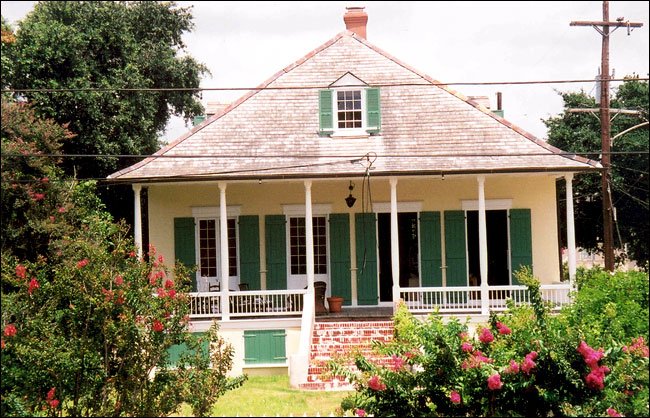
the author's home, before the flood
I have a stack of neglected newspapers on my right as I sit here at my laptop looking at the staggering reports of human tragedy flowing in from Louisiana, Mississippi and Alabama. I saved yesterday's NYTimes "House & Home" section for later, mostly because of this article [with another, very different picture] which appeared at the top of the front page. A few minutes ago, while looking for something else, I saw it for the third time on Tyler Green's site.* I decided I had to read it now, and I'm glad I did. In the midst of so much reason for despair, the writer, Frederick Starr, recalls a community which has been all but destroyed this week, but he also offers some hope for its survival.
My home is there, a West Indian-style plantation house built in 1826, standing as an ancient relic amid a maze of wooden houses a century younger. Some are classic bungalows, but most are distinctly New Orleans building types, with fanciful names like shotguns and camelbacks. I watch as a neighbor is rescued from his rooftop. Dazed, he has emerged from his attic, wriggling through a hole he hacked in the roof, swooped up by a Guardsman on a swinging rope. He is safe. Scores of others aren't. Bodies float through the streets of the Ninth Ward. Presumably they are from the diverse group that inhabits this deepest-dyed old New Orleans neighborhood: poorer blacks and whites, Creoles of color and a sprinkling of artists.My neighbor Miss Marie is also one of the lucky ones. Born on the ground floor of what is now my house, she is 81, residing in a shotgun house that her husband, now deceased, built 60 years ago. She has spent most of her life within a perimeter of barely 30 yards. Both her speech and her cooking were formed right there. A painted plaster statue of the Virgin has protected her through all previous storms. But this time she pleaded with my friend John White to take her as he left town. Satellite photos show the shadow of her roof beneath the filthy water. Her house is gone, but John saved her life, driving to Atlanta, sleeping on benches at rest stops.
. . . .
We are just beginning to appreciate the human disaster occurring in New Orleans and the Gulf Coast. Hundreds, maybe thousands, have already perished. Hundreds of thousands will lose their homes and all their worldly possessions. Untold numbers of businesses will close their doors, throwing huge numbers of people out of work. New Orleans, its population already in decline, now faces economic and social collapse.
It also faces the loss of some of America's most notable historic architecture. Maybe not in the French Quarter, which may emerge relatively intact, or the Garden District, which was spared most of the flooding. The dangers lie in neighborhoods like Tremé and Mid-City, which extend along Bayou Road toward Lake Pontchartrain and are rich in 18th- and 19th-century homes, shops, churches and social halls. They have been badly hit by the violent winds or torrents of water. And so have hundreds of other important buildings and vernacular structures throughout the city and across the breadth of South Louisiana and the Gulf Coast.
. . . .
Louisiana, especially South Louisiana, is a living archive of American social and cultural history, and not just in its buildings. In no other state is the proportion of people born and raised within its borders so high. As a consequence, they are something that is ever more rare in a homogenized and suburbanized America: the living bearers and transmitters of their own history and culture. Katrina, and those fateful levee breaks in New Orleans, put this all at risk.
. . . .
Now [my own house] is under water. If it survives at all, it will need massive rehabilitation. Just as likely, it will go the way of Miss Marie's house and of hundreds of other pieces of the region's heritage.
But I do not intend to give up easily. Why? Because I am absolutely convinced that New Orleanians will not allow their city to become a ghost town. And I intend to be part of the renewal that springs from this determination.
*
Go to Green's site, "Modern Art Notes," for regular updates on cultural loss in the Gulf area, and suggestions on how to help, along with very helpful links.
[image from the NYTimes]